Local News
Local MPs nominate additional Jewish community members for King Charles Coronation Medals
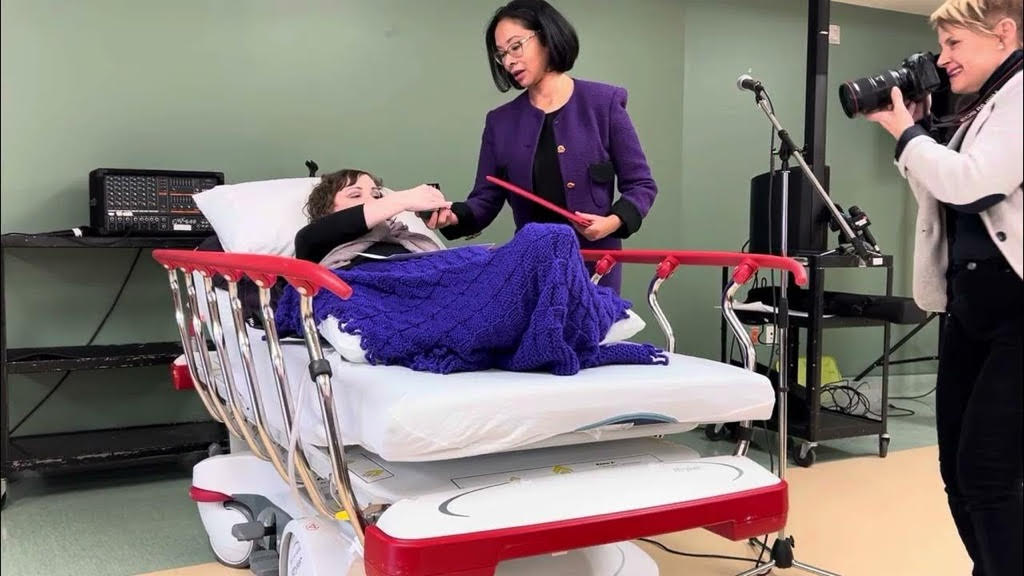
A few months back we published a story on this website about several members of the Jewish community who had been awarded King Charles Coronation Medals. That story can be found at King Charles Medals
Since that time it has come to our attention that several other members of our community had also been nominated by local Members of Parliament to receive medals.
Following is an update to that earlier story, which was also written by Myron Love:
The medal, created to mark the coronation of King Charles III, is described in a press release as a “special commemorative honour awarded to individuals who have demonstrated exceptional service and dedication to their communities and Canada through volunteerism, leadership, and acts of courage or commitment, reflecting the values of service and unity upheld by the monarchy. It serves as a lasting symbol of appreciation for their selfless efforts in building a better society”.
At the time, I was working largely from a list of local honorees posted on the Lieutenant-Governor’s webpage. Since then, it has been brought to my attention that other deserving members of our Jewish community have also been awarded the medals. It seems that it was not only the Lieutenant-Governor’s office which submitted a list of prospective honorees, It seems that every Member of Parliament was also encouraged to nominate honorees among their constituents.
Thus, local MPS Ben Carr and Marty Morantz –subsequent to the Lieutenant-Governor’s medal presentations – have released their own slates of medal recipients. Among the new Jewish honorees are two Jewish Federation of Winnipeg leaders – one fairly recently retired and a second who is still actively involved, a retired judge, a musician who has played a leading role in Winnipeg folk music circles, a pioneering veterinarian and a long time advocate for the disabled.
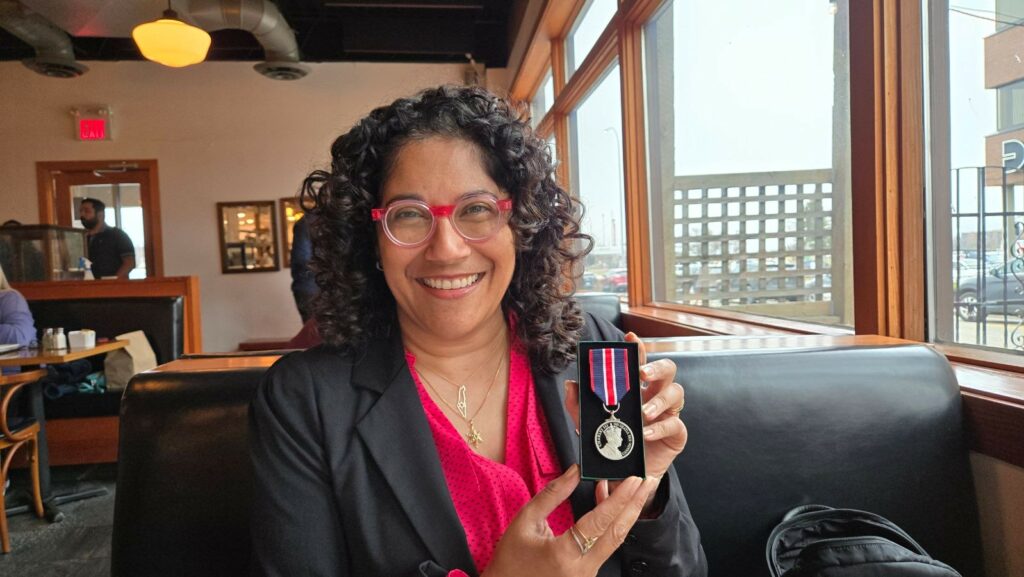
Jessica Cogan was actually presented with her medal (along with Einat Paz who appeared in the original story) – in mid-November in Marty Morantz’ constituency office. Cogan has been volunteering with the Jewish Federation of Winnipeg in numerous capacities for decades. Currently she is the Jewish Federation of Winnipeg’s Second Vice-President, a member of the board of Ben-Gurion University of the Negev, and a member of the advisory/organizing team for the Holocaust Memorial Sites Study Tour for Educators. She is a Past President of the Jewish National Fund (Manitoba-Saskatchewan branch) and National JNF board member, as well as a former Folklorama adult ambassador for Shalom Square.
In the wider community, she has served as a director of the Women’s Health Clinic Board and co-chaired their capital campaign.
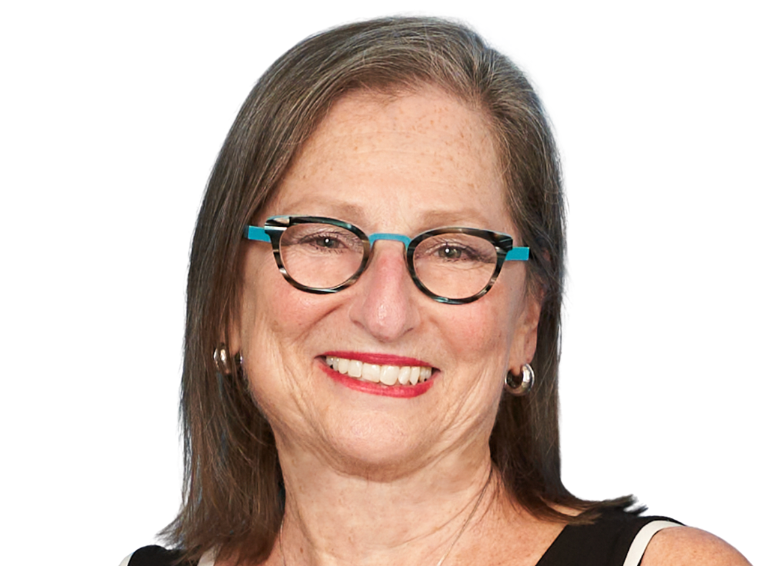
Elaine Goldstine admits to being “quite surprised” to have been nominated through Ben Carr’s office for the King Charles Award. Like Jessica Cogan, Goldstine has devoted most of her adult life first as a volunteer for the Federation and, over the past 20 years, as a senior member of our community’s “civil service”.
But her volunteer efforts go back even further. As noted in an earlier issue of the Post – in an interview with her two years ago – just prior to her retirement as the Federation’s CEO, as a teen, she was active in USY and was President of the Gabriels Chapter of BBYO. In 1979 she became involved with National Council of Jewish Women, and served as President of the Sarah Branch, President of the NCJW Winnipeg section, and as the organization’s National Treasurer and Vice President. She had also served on the PTA of Ramah Hebrew School, the Business and Professional Development Committee of Canadian Friends of the Hebrew University, and on the Board of the Shaarey Zedek Sisterhood.
She began volunteering with Federation after her two sons reached school age. She started as a volunteer with the CJA’s Women’s Philanthropy Division. After a short time, she was offered a job with the campaign. Eventually, she was hired to become the campaign division chair. She assumed the reins of the CJA campaign in 2004 after her predecessor, Gerry Koffman, passed away at a relatively young age.
In 2015, after the retirement of long time Federation CEO Bob Freedman – and a successor who left after a year – Elaine was tapped to become the new CEO.
Looking back over the course of her career serving our community, she feels a sense of satisfaction for a job well done – and gratitude for having had the opportunity.
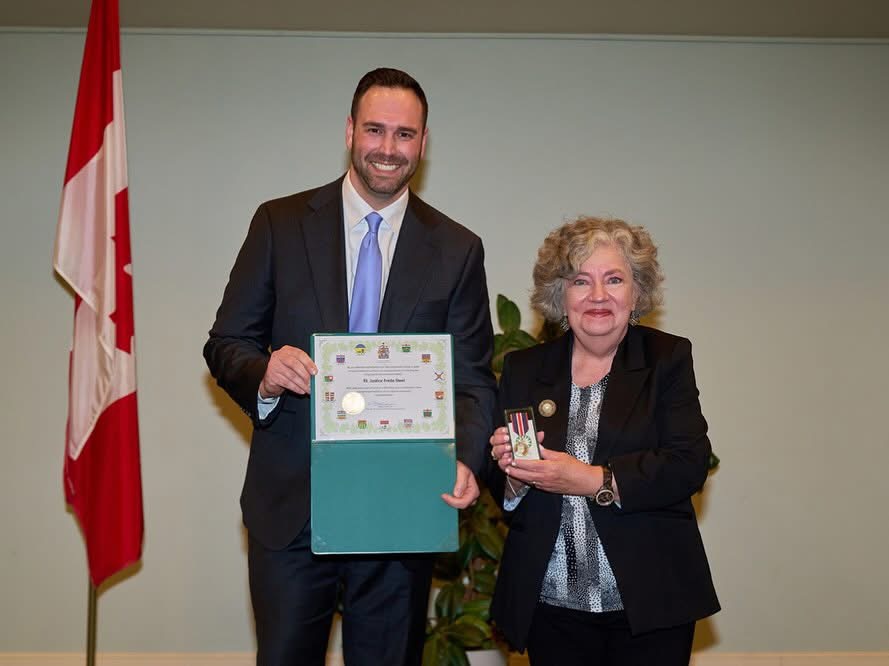
Madame Justice Freda Steel also notes that she was “surprised and humbled” to have been nominated to receive the medal which, she reports, was presented to her at Ben Carr’s office – along with some of the MP’s other nominees – on Monday, March 3. “I do not know who nominated me for the medal,” she says. “I just got a letter from Ben Carr’s office telling me I was a recipient of the medal and that the medal was for community service.“
As with Goldstine and Cogan, Steel has a long history of leadership in our Jewish community. She has been a board member and/or held leadership positions with the Federation, the Jewish Foundation of Manitoba, the Rady Centre, the Asper Jewish Community Campus and the Winnipeg Board of Jewish Education.
In her professional life, she has a Bachelor of Laws degree from the University of Manitoba and a Masters of Law from Harvard. For much of her career, she was a Professor of Law – first in Ottawa, then at her alma mater. She was appointed to the Manitoba Court of Queen’s Bench in 1995 and to the Court of Appeal in 2000. She stepped down from the court last year, but remains active as an arbitrator and mediator.
“My parents taught me that it was important to give back to your community and I have always tried to live up to the values that they inspired in all of us,” she says.
“I was honoured to be included along with so many accomplished individuals,” says Karen Dana, who was also one of Ben Carr’s nominees.
The daughter of Nate and Phyllis Dana was recognized for her lifelong contributions to the music scene in Winnipeg. A social worker by profession, Dana’s avocation has been folk music, primarily as a member of the organizing committee of the annual internationally-known Winnipeg Folk Festival. She began volunteering at the festival early on, serving for many years as backstage kitchen co-ordinator. As well, 30 years ago, she established an apprentice program for the festival, aimed at bringing in younger volunteers.
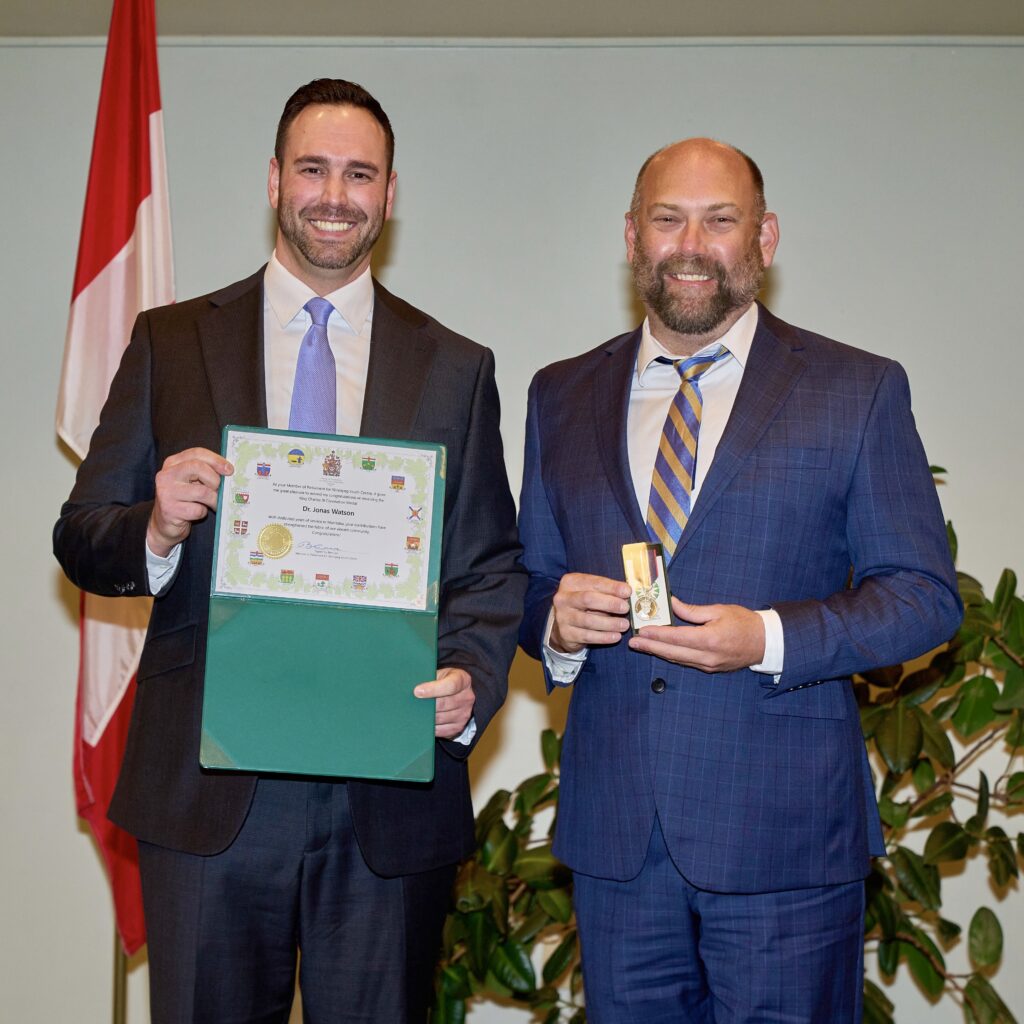
For veterinarian Dr. Jonas Watson, receiving the King Charles III Coronation Medal was “a tremendous honour”. he award, he notes, as presented to him in recognition for his leadership locally, nationally and internationally in animal health and welfare.
In a profile I wrote about Watson for this newspaper six years ago, the owner of Grant Park Animal Hospital in the rant Park Festival Centre on Taylor Avenue spoke about what he referred to as his philanthropic outreach was inspired, he recalled, by his participation in a spay-neuter clinic in the northern Saskatchewan community of Île-à-la-Crosse during his university studies where he saw first-hand the critical need for veterinary services in remote communities.
Among the initiatives he has led over the past few years are regular “0ne health” clinics up combining veterinarians and other healthcare professionals in neighbourhoods that have a disproportionately large number of vulnerably-housed or homeless people – providing vaccinations and deworming for their pets and dental care, flu shots and other services for the pet owners.
As well, he and his team regularly visit isolated parts of northern Manitoba and Nunavut to spay and neuter the dogs in these communities. And , farther afield, he has been recruited to provide his spay and neuter services to underserviced communities in Mexico and villages bordering national parks in the Indian Ocean island of Madagascar– to alleviate the dogs’ impact on endangered species – specifically lemurs,”
The graduate of the Hebrew bilingual program at Sir William Osler (now at Brock Corydon) elementary School points out that “an entire section of Jewish law- the concept of “tsa’ar ba’alei hayim”- prescribes that all animals be treated with compassion, and spared any suffering”.
”This notion has been the driving force behind everything I’ve done professionally over the last 25 years,” he says. “It is in fact the reason I pursued a career in veterinary medicine in the first place. And so, to be awarded this medal for what has been my life’s work is truly humbling. The fact that this work is being highlighted now is, I hope, a promising sign for the animals themselves.”
Among the most recent members of our community to have been awarded the Coronation medal is Dan Saidman, the Gwen Secter’s popular program director.
“I was really surprised,” says Saidman, who was presented with the award this past Saturday by Raquel Dancho, the Member of Parliament for Kildonan-St. Paul.
The honoree notes that he has been recognized for his work at the Gwen Sercter Centre over the past seven years. Previous to coming to the north Winnipeg seniors’ centre, he had served as director of BBYO for a time – followed by programming stints at the Waverley Retirement Home and the Heritage Lodge personal care home.
Saidman describes his time working at the Gwen Secter as the best job he has ever had. “It is a nice working environment and the staff and membership have been great,” he says.
A particularly notable honoree was the recently deceased Shawna (Shoshana) Forester Smith. I only learned about Smith – and her membership in our Jewish community when I was contacted by her husband, Brent, after my original report “Jewish Coronation medal recipients” was published int this paper in early January.
Some readers may be familiar with Smith’s name from the regular column she wrote for the Free Press in her role as an advocate for hospitalized patients like herself in long term care.
Shoshana and Brent became part of the Temple Shalom family about 15 years ago. “It was important to Shawna to explore her spirituality and find the right home and community for that aspect of her life and she found those things with Temple Shalom,” Brent recalls.
“I first met Shawna when I subbed for Rabbi Karen in the Intro to Judaism class at Temple Shalom in 2011,” he says. Longtime Temple Shalom president Ruth Livinston recalled standing beside Smith’s bedside at the Deer Lodge Hospital on the occasion of Smith receiving the Coronation medal . “We had a good connection right from the start. Besides attending services, Shawna came to study watercolour and the read Hebrew program with me, she painted a couple of kippahs and even came to a challah baking class. I had the honour of sitting on her Beit Din and helped her prepare for her Bat Mitzvah. She was a member of Temple Shalom’s Board of Trustees and managed our social media presence.
“When she decided to live at Riverview, she changed our weekly visits to include a watercolour class which she shared with her ward…that went on until Covid. We continued to meet weekly after Covid, including after her move here, to Deer Lodge. I treasure my visits with her – she had become family to me.”
In accepting the medal, Smith recounted her career in management for the Winnipeg Regional Health Authority until she became ill in her late 20s and had to go on permanent disability. Once she became a chronic care patient in the care of the health system, she used her public relations and healthcare background to advocate on behalf of patients with some success in bringing about positive change.
Sadly, Shoshana Smith passed away just about a month after receiving her Coronation medal. “Shawna is the bravest person I have ever met,” Livingston says. “In spite of ever increasing disability and agonizing pain, she made the decision to live to the best of her ability, to keep fighting for what she needs as well as for others.
“For one little woman with so many challenges, Shawna made an enormous and important impact on our community and beyond. I am thankful and delighted that she was honoured with the King Charles Coronation medal for her work in advocacy.”
Local News
Newly announced Vivian Silver Centre for Shared Society to further former Winnipegger’s lifelong efforts to foster Jewish-Arab co-operation in Israel

By MYRON LOVE Vivian Silver (oleh Hashalom) devoted her life to working toward dialogue and collaboration between Arabs and Jews in Israel. The culmination of her efforts was the Arab-Jewish Center for Empowerment, Equality, and Cooperation – Negev Institute for Strategies of Peace and Economic Development (AJEEC-NISPED), which she co-founded 25 year ago with her sister peace activist, Dr. Amal Elsana Ahl’jooj.
Tragically, Vivian was of the 1,200 Israeli Jews, Bedouin and foreign farm workers who were slaughtered during the Hamas-led pogrom of October 7, 2023.
Last month, AJEEC-NISPED announced plans to create the Vivian Silver Center for Shared Society in her memory – a new national hub for Jewish-Israeli Arab collaboration and social innovation in Be’er Sheva – backed by an initial $1 million donation from UJA-Federation of New York, along with support from the Meyerhoff Foundation, the Gilbert Foundation, and other philanthropic partners committed to strengthening shared society in Israel.
“It’s a great honor and a beautiful gesture,” comments Vivian’s son, Yonatan Zeigen, “and I hope it will be a central building for civil society, both in the physical sense, that it will become a substantial home for the organization and for other initiatives that will use the spaced and also symbolically, as a beacon for this kind of work in the specific location in the Negev.”
As this writer noted n an article earlier this year in relation to the announcement of the launch of the Vivian Silver Impact Award by the New Israel Fund (NIF) – of which she was a long time board member, and which was developed in conjunction with her sons, Yonatan and Chen), Vivian made aliyah in 1974. She first went to Israel in 1968 – to spend her second year at university abroad at the Hebrew University of Jerusalem, studying psychology and English literature.
In an article she wrote in 2018 in a publication called ”Women Wage Peace,” she related that during her final year at the University of Manitoba, she was among the founders of the Student Zionist Alliance on campus and was invited to its national conference in Montreal. There she met activists in the Habonim youth movement who planned on making aliyah and re-establishing Kibbutz Gezer. The day she wrote her last university exam, she boarded a flight to New York to join the group.
She spent three years in New York, where she became involved in Jewish and Zionist causes, including the launch of the Jewish feminist movement in America.
“It was a life-changing period,” she recalled. “I came to understood that in addition to being a kibbutz member, I was destined to be a social change and peace activist.”
Vivian and her group made aliyah in 1974 and settled on Kibbutz Gezer. In 1981, she established the Department Promoting Gender Equality in the Kibbutz Movement. She moved to Kibbutz Be’eri near the Gaza border in 1990, along with her late husband, Lewis, and their two sons
In 1998, Vivian became the executive director of the Negev Institute for Strategies of Peace and Development in Beer Sheva, an NGO promoting human sustainable development, shared society between Jews and Arabs, and peace in the Middle East. Soon after, she was joined by Amal Elsana Alh’jooj as co-directors of AJEEC-NISPED, winning the 2011 Victor J. Goldberg Peace Prize of the Institute for International Education.
In the article she wrote for “Women Waging Peace,” she noted that “while we later focused on empowerment projects in the Bedouin community in the Negev, initially we worked with Palestinian organizations on joint people-to-people projects. I spent much time in Gaza until the outbreak of the second intifada. We continued working with organizations in the West Bank. I personally know so many Palestinians who yearn for peace no less than we do.”
According to a report in the Israeli newspaper Arutz Sheva, in the November 24th edition, the Vivian Silver Centre – which is expected to open in the spring – will be located within AJEEC-NISPED’s soon-to-open AJEEC House, and will provide a permanent home for programs that promote equality, leadership, and cooperation among Israel’s diverse communities.
“The Vivian Silver Center for Shared Society, within AJEEC’s headquarters, “the Arutz Sheva report noted, “will serve as a regional platform for dozens of Israeli Arab and Jewish social organizations. Through AJEEC’s educational, vocational, and leadership programs, the center will support thousands of young adults each year – offering mentorship, professional training, and opportunities for cross-cultural collaboration.
“These programs,” the report continued, “already reach more than 15,000 participants nationwide, helping young people integrate into higher education and meaningful employment while narrowing social and economic gaps.”
AJEEC House is located in Be’er Sheva’s Science Park, near Ben-Gurion University. The three-storey AJEEC House has been designed to foster cooperation and dialogue. It will host community partnerships, provide shared workspaces for social entrepreneurs, and serve as a hub for initiatives addressing social and economic development across the Negev and beyond.
Readers who may be interested considering a donation can dial into NISPED’s website – – for further information.
Local News
Stanley Schwartz- it’s a long way from Waterloo

By GERRY POSNER For Stanley Schwartz, it all began on Waterloo Street. For those who remember the 1950s and 60s – take yourself back to the south end of Winnipeg. Waterloo between Corydon and Fleet had enough Jewish families to form its own High Holiday congregation. That is to say, there were a whole bunch of Jewish families there. Not quite McAdam Avenue in the north end – but close enough. One such family was that of Harold and Faye Schwartz, along with their children: Anita, Ruth, and Stanley.
Stanley graduated from Kelvin High School. In fact, he played football for the Kelvin Clipper. In addition, he was a participant in typical Jewish teen activities at the time, particularly AZA. He had a wide network of friends, some of whom remain vital connections to this day. Remember, in those days, there were no cell phones, no internet, and barely the beginnings of TV. So, as a teenage boy, Stanley spent a lot of time with his buddies.
Stanley went on to the University of Manitoba from where he graduated law in 1967. That was Stanley’s first step into a career that lasted close to 50 years. His second big step was his decision to forgo an offer to become a partner in a well known and established law firm in Winnipeg, and instead, go out on his own in a shared space arrangement. The shared space arrangement lasted several years and, during that time, he also opened up an office in Morris, Manitoba. Morris was once home to several Jewish families, but not when Stanley moved there to live.
Along his way to practicing law, Stanley got married – to the former Shirley Hooper, a woman originally from England who had moved to Vancouver and whom Stanley met by chance in Hawaii. They were blessed with two children and now have five grandkids. But the family did not end up in Winnipeg. In what was a huge life changing decision at that time, Stanley and Shirley boldly packed up their belongings and moved to Vancouver. Now, some of the thinking that entered into this move might well have been Shirley’s lack of fondness for the Manitoba winters (even though she had formed close relationships with many people in Winnipeg at that time – relationships she still maintainsto this day). But Stanley was also open to a fresh start in a new place. That decision, looking back on it now in 2025, was a wise one for both Stanley and Shirley Schwartz. For starters, who knew that Vancouver would explode with an immigrant population and with it, a dramatic increase in the value of property, caused in part by non-residents buying up land and buildings in Vancouver? Aside from that, Stanley had a specialty in his practice of law that was a perfect fit for Vancouver’s growing population- family law.
For the entirety of his legal career, Stanley focused on matrimonial law in every aspect, not the least of which was litigation. As a former lawyer myself, let me say that if there is an area of law filled with tension, aggravation, and sadness, it surely must be the field of marriage, children and custody battles, access, division of assets and all that goes with those issues. You often are not just a lawyer, but also a psychologist, father confessor and a lot more. You really have to be able to be able to watch some of the worst in humanity. And you have to be ready to, as they say, “ go for the jugular.”
You may never have to do it, but you have to be ready. Stanley Schwartz was ( nd remains so this day, in my view) on the face of it, not a likely candidate to be thought of as aggressive.That is because he was then and still is now, a friendly guy who does not seem to be one cut out for courtroom battles. But clearly, he was able to be “ rough and tough” when he had to be. When I asked Stanley what advice he would give to somebody wanting to employ him in a family law situation, he was quite frank. His immediate response to these kinds of clients was: “If you want a war, the winners will be two people -the two lawyers. The losers will be your children ( f there are kids in the picture.”)
Stanley might still have been at it, but he had medical issues relating to his back over a period of many years. He has had three spinal surgeries, and none of them has really worked satisfactorily. Standing for periods of time was hard for Stanley. He says he knew it was time to give up his practice of law when one day in court six or seven years ago, while he was in argument, he leaned against the dais and the judge told him that it was ok for him to sit down and argue. That episode confirmed what he had thought for a while: time to call it a day and a career. So with two metal rods in his back and pain in his legs, Stanley retired.
Though no longer involved in the legal world, Stanley has managed, very easily he would add, to settle into his non working life with as much travel as he and Shirley are able to do. That travel includes trips back to Winnipeg, also Winnipeg Beach – where he spent much of his youth. His visits also include time with his sister, Anita Ruth Neville, a name not exactly unknown to Manitobans given her role as the 26th Lieutenant Governor for the Province of Manitoba. And, with one daughter in Toronto, Shirley and Stanley also make regular stops in that city to see his family there.
Not that long ago, Stanley stepped into the world of octogenarians. He is quick to say that getting old is not for sissies, but at the same time, he is one to embrace what each phase of his life has brought.
Local News
Farah Perelmuter – a former Winnipegger in the spotlight

By GERRY POSNER From the north end of Winnipeg, Garden City to be exact, comes yet another Winnipeg woman who has almost singlehandedly built a prosperous business in Toronto – almost out of the blue. And who is this Winnipeg woman? None other than Farah Perelmuter, bornFarah Vinsky, the oldest of Toby and Irv Vinsky’s three daughters.
Farah attended Talmud Torah and Joseph Wolinsky Collegiate, also spent a year at the University of Winnipeg Collegiate. Upon graduation from high school, Farah took a gap year in Toronto working in the modelling industry. During that year, she had a chance to visit Western University in London, Ontario. That visit inspired her to apply there and, after one year at the University of Winnipeg, she was off to Western. Interestingly, not that long ago, Farah served on the Western Alumni Board – a role she filled for six years.
As a teenager in Winnipeg, Farah indicated that she had an entrepreneurial gene, as evidenced by her creating what was a “ self development “ program for teenage girls. When she started that program, Farah was all of 16 and was already working in her spare time in a modelling agency. When she came to Toronto after her graduation from university, she began working at a marketing agency, but the desire to be her own boss was so strong that, in 1995, Farah, along with her husband, Martin Perelmuter, started a business known as “ Speakers Spotlight.”
The business’s purpose was to bring prominent speakers to address audiences at locations all over the world. The couple initiated the business right from the spare bedroom in their apartment – with only one phone and one computer. Worse than that, Farah and her husband had no clients, no experience, no staff and, of course – no money. What they had was a clear vision. That vision was to put the right speaker in front of the right audience and, if they could do that, the impact would be significant and lasting. They also had so little business experience that they tried out different ways of doing things in their business and were not afraid to be innovative. That willingness to create and change likely propelled them speedily into the forefront in their field. As proof of their standing in the industry, Farah and Martin were selected twice as Entrepreneurs of the Year by Ernst and Young.
From that modest beginning emerged what is today called “ Speakers Spotlight,” a business that has grown into one of the world’s largest and indeed most respected speakers’ agencies. Farah and Martin have developed a team of people working for and with them (now up to 35 people, who work both in and out of the office) and, as well, they have created an incredible roster of extraordinary speakers. Their list of speakers includes people with deep experience in their respective fields. That combination of prominent speakers and a loyal, dedicated group of people putting the speakers on to platforms has allowed “Speakers Spotlight” to raise the bar of professional service and integrity within the industry. Would you believe 40,000 speaking engagements over 50 countries are now part of the history of a business that started in Farah’s spare bedroom? Just the list of names who have participated with Speakers Spotlight is staggering. Google Speakers Spotlight and I promise you will be overwhelmed, both by the quantity and quality.
Along the way, the company has received numerous awards and accolades. Most importantly, they have, through the various people that have been involved as speakers, helped to plant the seeds for people in the audience to make changes, alter plans and to inspire them to go forward. Sometimes, it’s as little as hearing the right person tell a story that can affect one person and from there, big things often develop. For Farah, that is what keeps her excited about her business.
In 2017, the couple started another business related to the first one, called “ The Spotlight Agency.” This company connects celebrity talent with opportunities all over the world. The talent comes from every area of life including the fields of entertainment, sports, food, decor and more. What the Spotlight Agency does is to unite these personalities to a brand of partnerships, with digital and creator content,TV, streaming, podcasts and publishing.
Even with the real success of Farah’s business ventures, what pushes her are her two children, Jade and Cole, both now in their 20s, and forging their own trails. As well, Farah appreciates from whence she came and she looks forward to what lies ahead. She treasures her return trips to Winnipeg to see her parents, relatives and indeed, old friends. So much is Farah Perelmuter a true Winnipgger that she still roots for the Winnipeg Jets, especially when they play the Toronto Maple Leafs. So, let the spotlight shine on Farah Vinsky Perelmuter.


